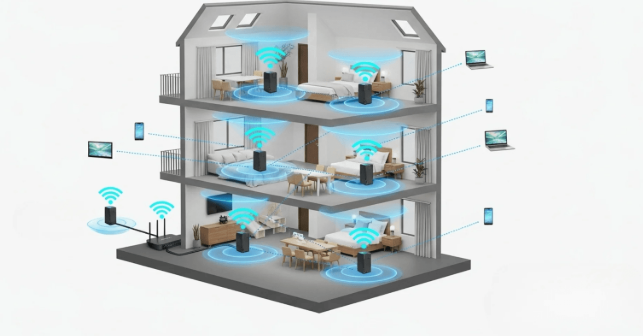Living in a multi-floor home provides comfort, but WiFi can often feel like an ongoing challenge. One moment you’re streaming smoothly in the living room, and the next, the signal drops when you head upstairs. Thick walls, multiple floors, and heavy device use make it hard for a single router to cover everything. Fortunately, there are proven methods to expand coverage and improve reliability, and it’s wise to call a professional WiFi technician in Dubai for expert help.
Why Multi-Floor Homes Face WiFi Issues
- Obstacles: Concrete walls, floors, and ceilings weaken signals.
- Router limitations: A single router isn’t designed for large spaces.
- Interference: Nearby devices like microwaves or cordless phones add noise.
- High demand: Families often connect dozens of devices simultaneously.
Understanding the causes is the first step toward finding the right fix.
Step 1: Place Your Router Strategically
- Position it in a central, elevated location on the middle floor.
- Keep it away from thick walls, large appliances, or hidden corners.
- Avoid placing it near glass or metal surfaces, which reflect signals.
Good placement alone can improve coverage by 20–30%.
Step 2: Use Dual-Band or Tri-Band Routers
- 2.4 GHz band: Better for long-range but slower speeds.
- 5 GHz band: Faster speeds but shorter range.
- Tri-band routers: Add an extra 5 GHz band for smoother performance.
For multi-floor homes, using dual or tri-band routers ensures devices can switch seamlessly between bands for stronger connections.
Step 3: Add WiFi Extenders
WiFi extenders are a budget-friendly way to eliminate dead zones. Place them halfway between the router and weak-signal areas.
Pros: Affordable, simple to set up.
Cons: Speeds may drop slightly since they rebroadcast the signal.
Step 4: Upgrade to a Mesh WiFi System
Mesh WiFi is ideal for multi-floor homes. Multiple nodes placed around the house create one unified network.
Advantages of Mesh Systems:
- Single SSID (no need to switch networks).
- Seamless roaming between floors.
- Scalable: Add more nodes as needed.
- Strong performance even in large villas.
For a Dubai-style multi-floor home, a mesh system often provides the most stable long-term solution.
Step 5: Use Wired Connections (Ethernet Backhaul)
For maximum stability, connect mesh nodes with Ethernet cables. This wired backhaul ensures full internet speed is available on each floor, with no signal loss.
Step 6: Optimize Device Placement and Settings
- Place extenders or mesh nodes in open spaces, not inside cabinets.
- Update router and extender firmware regularly.
- Limit bandwidth-hogging devices during important tasks like video calls.
- Use Quality of Service (quality of service) settings to prioritize work devices or streaming.
Step 7: Secure Your Network
Sometimes slow WiFi isn’t about coverage—it’s about unauthorized users.
- Change your WiFi password regularly.
- Enable WPA2 or WPA3 encryption.
- Set up a guest network for visitors.
When to Call a WiFi Technician in Dubai
DIY fixes can go a long way, but if you still face issues like:
- Dead zones even after adding extenders.
- Frequent disconnections while moving between floors.
- Difficulty setting up mesh systems or Ethernet backhaul.
- Complex network requirements for smart homes.
…it’s time to call a professional WiFi technician in Dubai. Experts can analyze your home’s layout, recommend the best solution, install equipment properly, and secure the network for long-term performance.
Conclusion
Maximizing WiFi coverage in a multi-floor home involves more than just a strong router. Strategic placement, extenders, mesh systems, and wired connections all help ensure smooth connectivity across levels.
Want to know about Nano Banana AI: The Creative Powerhouse That’s Redefining Visual Content Creation Check out our Blog category.

